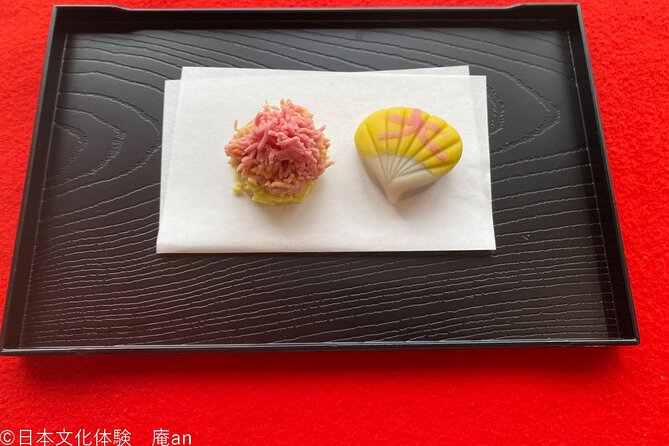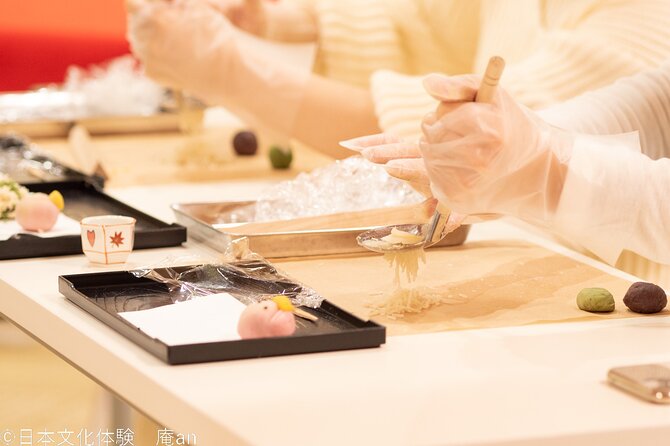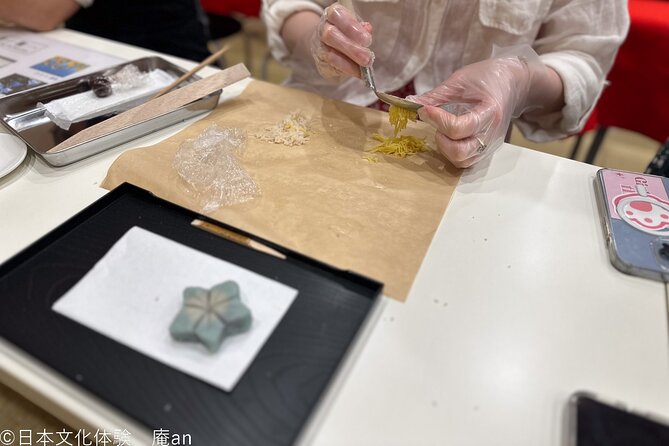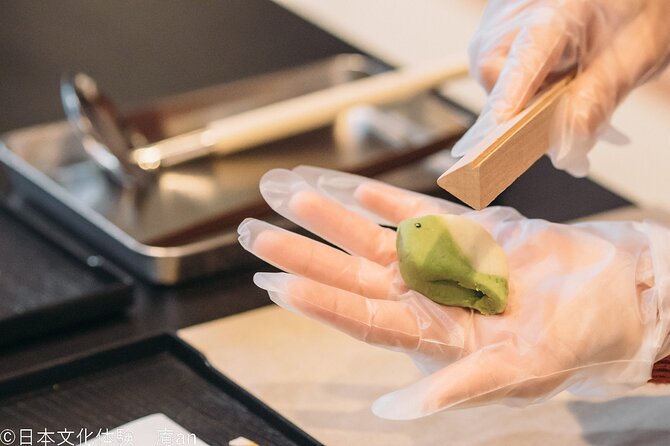Making traditional Japanese sweets, or wagashi, is a captivating art form that’s steeped in centuries of cultural heritage. These delicate confections blend natural ingredients like rice flour and sweet bean paste with intricate techniques that require specialized tools and immense skill. While the process may seem complex, the end result is a delightful treat that not only tantalizes the taste buds but also embodies the essence of Japan’s rich culinary legacy. Exploring the world of wagashi reveals a fascinating glimpse into the country’s timeless traditions and attention to detail.
Good To Know

- Master the specialized tools like a flat wooden board, small knife, and various molds to handle the delicate ingredients of traditional Japanese sweets.
- Meticulously measure and expertly combine ingredients like mochi, anko (sweet bean paste), kurogoma (black sesame), and food colorings to create authentic wagashi.
- Precisely execute the preparation techniques of steaming, kneading, and molding the ingredients to achieve the desired texture and appearance of Japanese sweets.
- Understand the historical significance and cultural symbolism behind traditional Japanese sweets to incorporate elements of nature and aesthetics into your creations.
- Experiment with popular wagashi varieties like mochi, daifuku, manju, dorayaki, and taiyaki to expand your repertoire of traditional Japanese sweet-making skills.
What Are Japanese Traditional Sweets?

Japanese traditional sweets, also known as wagashi, are a diverse array of delicate confections that have been crafted for centuries in Japan.
These exquisite treats are made using natural ingredients like mochi, adzuki beans, and seasonal fruits. Wagashi often mimic the beauty of nature, with intricate designs that evoke flowers, landscapes, and even cultural motifs.
They’re typically served with green tea, complementing the flavors and textures.
These artisanal sweets aren’t merely desserts, but expressions of Japanese culture, aesthetics, and attention to detail.
Enjoying wagashi is a cherished ritual that provides a sensory delight.
You can also read our reviews of more tours and experiences in Kyoto
Tools and Ingredients for Making Japanese Sweets

To create traditional Japanese sweets, a variety of specialized tools and ingredients are essential. Wagashi makers use a flat wooden board, a small knife, and various molds to shape the delicate confections.
Key ingredients include mochi (sticky rice), anko (sweet bean paste), kurogoma (black sesame), and food colorings. Precise measurements and techniques are critical, as the fragile nature of these sweets requires careful handling.
The preparation process often involves steaming, kneading, and molding the ingredients into intricate designs. Mastering the art of wagashi-making takes time and patience, but the results are truly delightful.
The History of Japanese Sweets
The origins of Japanese sweets, known as wagashi, can be traced back centuries, reflecting the rich cultural heritage and aesthetic sensibilities of the country.
These delicate confections were initially created for Buddhist temple rituals, later evolving into treats enjoyed by the aristocracy and, eventually, the general public.
The traditional techniques and ingredients, such as red bean paste, rice flour, and seasonal fruits, have been meticulously passed down through generations.
Wagashi not only delight the palate but also captivate the senses, incorporating elements of nature, symbolism, and the profound appreciation of the ephemeral beauty inherent in Japanese culture.
Popular Types of Japanese Sweets

Among the most popular types of Japanese sweets are mochi, daifuku, and manju. Mochi are chewy rice cakes, often filled with sweet red bean paste.
Daifuku are mochi stuffed with a variety of fillings, such as sweet bean paste or fruit. Manju are buns made with wheat flour dough, typically filled with sweet ingredients like red bean paste or chestnut.
Other popular Japanese sweets include:
- Wagashi – Traditional Japanese confections made with high-quality ingredients like rice, beans, and seasonal fruits.
- Dorayaki – Pancake-like pastries filled with sweet azuki bean paste.
- Yakisoba – Fried noodle dishes often served as a street food snack.
- Taiyaki – Fish-shaped cakes filled with sweet bean paste or custard.
The Art of Decoration in Japanese Sweets
While traditional Japanese sweets are renowned for their delicate flavors, their visual appeal is equally captivating.
The art of decoration in Japanese confections is a meticulous process that elevates these treats into edible works of art. Skilled artisans use techniques like moulding, piping, and stenciling to create intricate patterns and designs.
Seasonal motifs, such as cherry blossoms or autumn leaves, are often incorporated, reflecting the Japanese reverence for nature.
The attention to detail and aesthetics is a hallmark of this culinary tradition, ensuring each sweet not only tantalizes the taste buds but also delights the eyes.
The Process of Making Japanese Sweets
Skilled artisans begin the process of making traditional Japanese sweets by carefully selecting high-quality ingredients.
The process involves:
- Measuring and preparing the ingredients with precision.
- Mixing the ingredients together to create the desired texture and flavor.
- Carefully shaping the dough into intricate designs, often using specialized tools.
- Steaming or boiling the sweets to ensure they’re cooked to perfection.
The attention to detail and craftsmanship is what makes these traditional sweets so revered.
The result is a delicate balance of flavors and textures that delights the senses and celebrates the rich cultural heritage of Japan.
Health Benefits of Japanese Sweets

Traditional Japanese sweets, or wagashi, are not merely delightful confections, but also offer notable health benefits. Unlike heavily processed Western candies, wagashi are made with natural ingredients like adzuki beans, rice flour, and seasonal fruits. Many varieties are low in sugar and calories, while providing fiber, vitamins, and antioxidants. The unique textures and flavors of wagashi can also aid digestion and promote mindfulness during consumption.
| Health Benefit | Explanation |
|---|---|
| Low Calorie | Wagashi are typically lower in calories than Western sweets. |
| Fiber-Rich | Many wagashi contain fiber-rich ingredients like adzuki beans. |
| Antioxidant-Packed | Seasonal fruits and vegetables used in wagashi are high in antioxidants. |
| Digestive Support | The unique textures of wagashi can help with digestion. |
Where to Experience Japanese Sweets Making
One of the best places to experience traditional Japanese sweets making is in Kyoto, the cultural heart of Japan. The activity is offered at a meeting point in Shimogyo Ward, where participants receive a set of tools and materials necessary for the experience.
The activity is wheelchair accessible and near public transportation, with a maximum capacity of 40 travelers. While the reviews are limited, with an overall rating of 4.0, the opportunity to learn the art of traditional Japanese sweets making in Kyoto is a unique and immersive cultural experience.
The key details are:
- Location: 135 Manjūjichō, Shimogyo Ward, Kyoto, 600-8104, Japan
- Price: From $11.89 per person
- Capacity: Maximum 40 travelers
- Reviews: Overall rating of 4.0 based on limited feedback.
Frequently Asked Questions
Can I Customize the Sweets I Make During the Experience?
The experience allows participants to create traditional Japanese sweets, but it’s not clear if they can customize the sweets they make. The activity follows a set format and provides the necessary tools and materials.
What Is the Level of Difficulty for This Sweets Making Activity?
The activity is described as a traditional sweets making experience, suggesting a moderate level of difficulty. Participants will work with pre-provided tools and materials, indicating the process is guided and suitable for beginners.
Are There Any Age Restrictions or Recommended Age Groups for This Activity?
The activity does not have any age restrictions and is appropriate for all age groups. It’s a fun and engaging experience suitable for both children and adults to learn about Japanese traditional sweets making.
Can I Take the Sweets I Make Home With Me After the Experience?
Yes, participants can take home the sweets they make during the experience. The activity description indicates that the experience includes the necessary tools and materials, allowing visitors to create traditional Japanese sweets and bring them back as a souvenir.
Are There Any Special Dietary Accommodations Available for This Sweets Making Class?
The experience doesn’t mention any special dietary accommodations. However, it’s best to contact the provider directly to inquire about any dietary needs or restrictions they can accommodate for the sweets making class.
The Sum Up
Japanese traditional sweets, or wagashi, are a delicate and intricate art form. The making process requires specialized tools, natural ingredients, and meticulous techniques that reflect Japan’s cultural heritage. Each step, from steaming to molding, demands patience and skill to create confections that delight the senses and embody Japanese aesthetics. Experiencing the art of Japanese sweets-making offers a unique glimpse into the country’s rich culinary traditions.
More Dessert Tours in Kyoto
- Kyoto Sweets & Desserts Tour With a Local Foodie: Private & Custom
- Arashiyama Highlights With Making Japanese Sweets
- Kyoto Sweets and Green Tea Making and Town Walk.
- Japanese Sweets Making With Seasonal Motifs
- Kyoto WAKIMIZU Half Day Tour: Secrets of Matcha & Wagashi Sweets
- Japanese Traditional Sweets Making and Tea Ceremony
More Tour Reviews in Kyoto
- Kyoto: Discover Every Bit of Ginkakuji Temple in 60 Minutes
- Private Full-Day Walking Tour of Kyoto
- Hidden Temples in Kyoto a Self-Guided Zen Tour
- 2 Hour Private Tour of Arashiyama Highlights
- Nara 9hr Tour Licensed Guide&Vehicle: Kyoto Pickup/Osaka Dropoff
- Kyoto: Half-Day Private Tour Gion Geisha Districts & Kiyomizu
Not for you? Here's more nearby things to do in Kyoto we have reviewed
- Hidden Kyoto- Countryside & Local Life – Private Car Tour
- Kyoto: Discover Every Bit of Ginkakuji Temple in 60 Minutes
- Private Full-Day Walking Tour of Kyoto
- Hidden Temples in Kyoto a Self-Guided Zen Tour
- 2 Hour Private Tour of Arashiyama Highlights
- One Way Bus From Kanazawa to Kyoto
- Nara 9hr Tour Licensed Guide&Vehicle: Kyoto Pickup/Osaka Dropoff
- Original Pizza Making Using Kyoto Vegetable at BNR Night Farm
- Kyoto 8 Hr Tour From Osaka: English Speaking Driver, No Guide
- Kyoto: Half-Day Private Tour Gion Geisha Districts & Kiyomizu
- Kyoto Sweets & Desserts Tour With a Local Foodie: Private & Custom
- Arashiyama Autumn Leaves & Sanzen-In Temple Tour From Osaka/Kyoto
